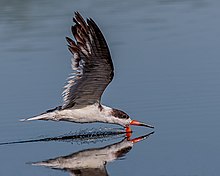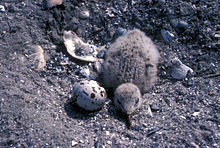Scissor beaks
| Scissor beaks | ||||||||||||
|---|---|---|---|---|---|---|---|---|---|---|---|---|

|
||||||||||||
| Systematics | ||||||||||||
|
||||||||||||
| Scientific name of the subfamily | ||||||||||||
| Rhynchopinae | ||||||||||||
| Bonaparte , 1838 | ||||||||||||
| Scientific name of the genus | ||||||||||||
| Rynchops | ||||||||||||
| Linnaeus , 1758 |
The scissor beaks ( Rynchops ) are a genus in the subfamily of the same name of the scissor beaks (Rhynchopinae) within the order of the plover-like (Charadriiformes). The genus includes three types.
features
Scissor beaks are between 40 and 47 centimeters long and resemble the tern in shape . The wings and beak are relatively large in relation to the body. The short legs are colored red or yellow. On the feet there are deeply incised webs, like all seagull relatives. The tail is long and forked. The plumage is black and white, the upper side of the wings, the coat and the upper head area are black, but the head cap does not extend to the beak, but is separated from it by a white area. The head is large and massive, the neck muscles particularly strong. As a specialty among birds, scissor beaks have slit-shaped pupils. Another special feature is the laterally flattened lower beak in the adult animals, which is significantly longer than the upper beak. The lower beak is narrow and sharp-edged at the base of the beak. As the tip wears out over time, the beak keeps growing back. The nostrils are located near the base of the beak close to the cleft of the beak. There is no sexual dimorphism in the plumage , the females are only slightly larger than the males.
Young birds have a paler, dark brown upper side, especially the wing feathers have a white border and give the plumage a scaled or irregularly dashed appearance.
Way of life
activity
The main activity phases of the scissors' beaks are in the evening and morning hours, so that they do not compete with terns in foraging. Occasionally they also hunt at night. Barking calls are made in the swarms during the hunt. During the day and at high tide, the birds rest sociable in large groups on high sandbanks or sandy and scree beaches.
Food and hunting
Scissors' beaks prefer to hunt in shallow water areas and places inaccessible to terns and gulls, such as murky waters. They feed on fish and crustaceans. The hunting flight takes place close to the water surface, where the bird flies along straight lines with its head down. The water surface is plowed through with an open beak. Only the tip of the lower mandible is held in the water. If it happens to come into contact with a prey, the beak is closed. The prey is then swallowed with the head thrown back, all without interrupting the flight. Hunting is done individually or in flocks. Due to the special hunting strategy, they are largely independent of the sense of sight and the cloudiness of the water.
Reproduction
Courtship involves handing over a small stick from male to female. With your feet and your body a hollow is carved into the ground and pressed. Two to five densely dark spotted eggs are laid and mainly incubated by the female. Scissors' beaks always breed in colonies on beaches, sandbanks and river banks. If the broods are destroyed by floods, replacement beds are used. The young birds, which are down after hatching, are looked after by both adult birds and also fed when they are able to fly. In the first few weeks, both halves of the beak are still the same length, so that food can also be taken from the ground if the chicks or parents drop it.
Occurrence
The brown-mantled scissors beak ( Rynchops flavirostris ) and the collar scissors beak ( Rynchops albicollis ) are freshwater birds and inhabit the tropics, the black-mantled scissors beak ( Rynchops niger ) inhabits coastal areas in North and South America. Scissors' beaks are sociable birds that occur in small groups near lakes, lagoons or river banks and catch prey in shallow water.
Systematics
Classically, the scissor beaks are placed as a separate family next to terns and seagulls. Recent phylogenetic analyzes have shown that this division into different families does not do justice to the actual relationships: the scissor beaks form the sister taxon to the gulls .
The following cladogram illustrates the family relationships:
| Laridae |
|
||||||||||||||||||||||||
|
|
The following three types are distinguished within the scissor beaks:
- Collared scissors beak or Indian scissors beak ( Rynchops albicollis Swainson , 1838 ) - South Asia
- Brown-coat scissors beak or African scissors beak ( Rynchops flavirostris vieillot , 1816 ) - Africa, south of the Sahara
- Black-mantled scissors beak ( Rynchops niger Linnaeus , 1758 ) - southern North America - three to four subspecies
literature
- Joseph Forshaw (Ed.): Encyclopedia of Birds. 1999, ISBN 3-8289-1557-4 .
- Richard L. Zusi: Scherenschnäbel family . In: Bernhard Grzimek (ed.): Grzimeks animal life. Encyclopedia of the Animal Kingdom . tape 8 : Birds 2 (edited by Bernhard Grzimek, Wilhelm Meise, Günther Niethammer, Joachim Steinbacher). Kindler Verlag, Zurich 1969, p. 225–227 (paperback edition: dtv, Munich 1980 and 1993).
- Theo Jahn: Brehm's new animal encyclopedia . Volume 7: Birds 3 . Verlag Herder KG, Freiburg im Breisgau, special edition Prisma Verlag GmbH, Gütersloh 1982, ISBN 3-570-08606-2 .
- Colin Harrison, Alan Greensmith: Birds. Ravensburger Buchverlag, Otto Maier GmbH, 1994, ISBN 3-473-46076-1 .
supporting documents
- ↑ a b Baker, AJ; Pereira, SL; Paton, TA (2007). Phylogenetic relationships and divergence times of Charadriiformes genera: multigene evidence for the Cretaceous origin of at least 14 clades of shorebirds. Biology Letters. 3: 205-209. doi: 10.1098 / rsbl.2006.0606
Web links
- Picture of the week , Der Spiegel 2018/45, November 2018


